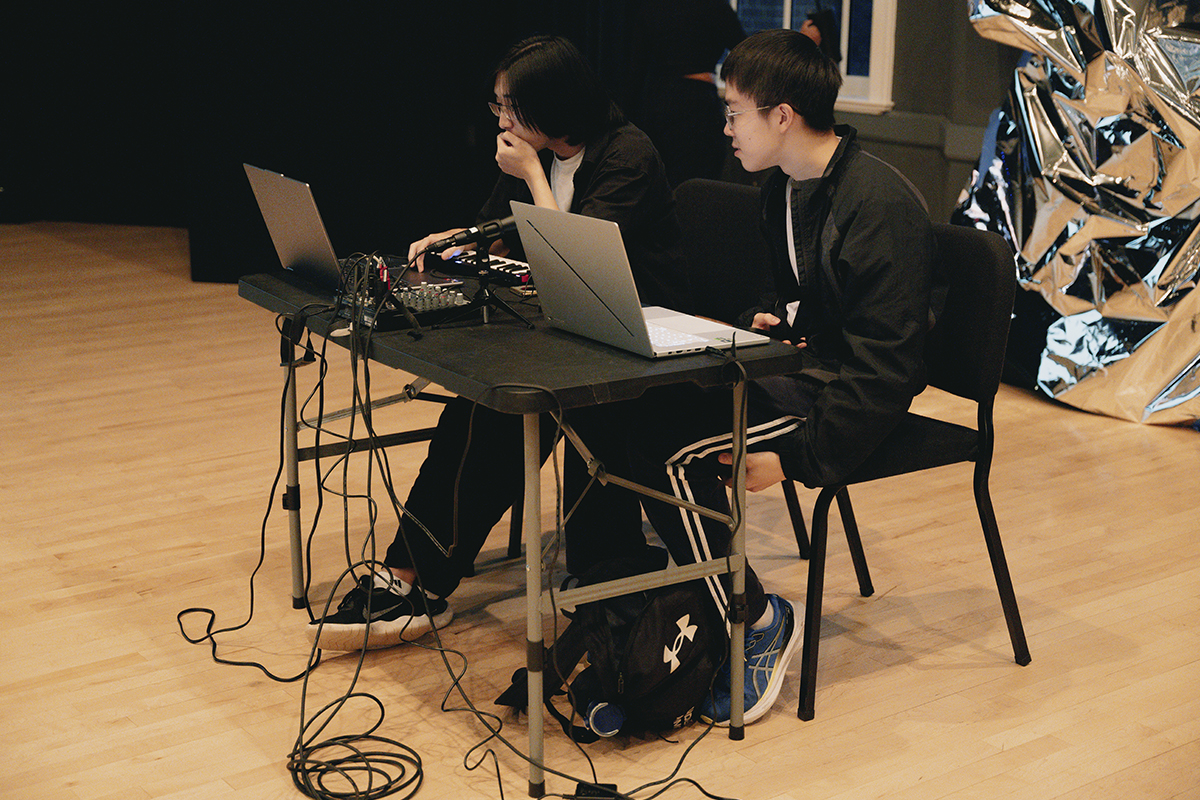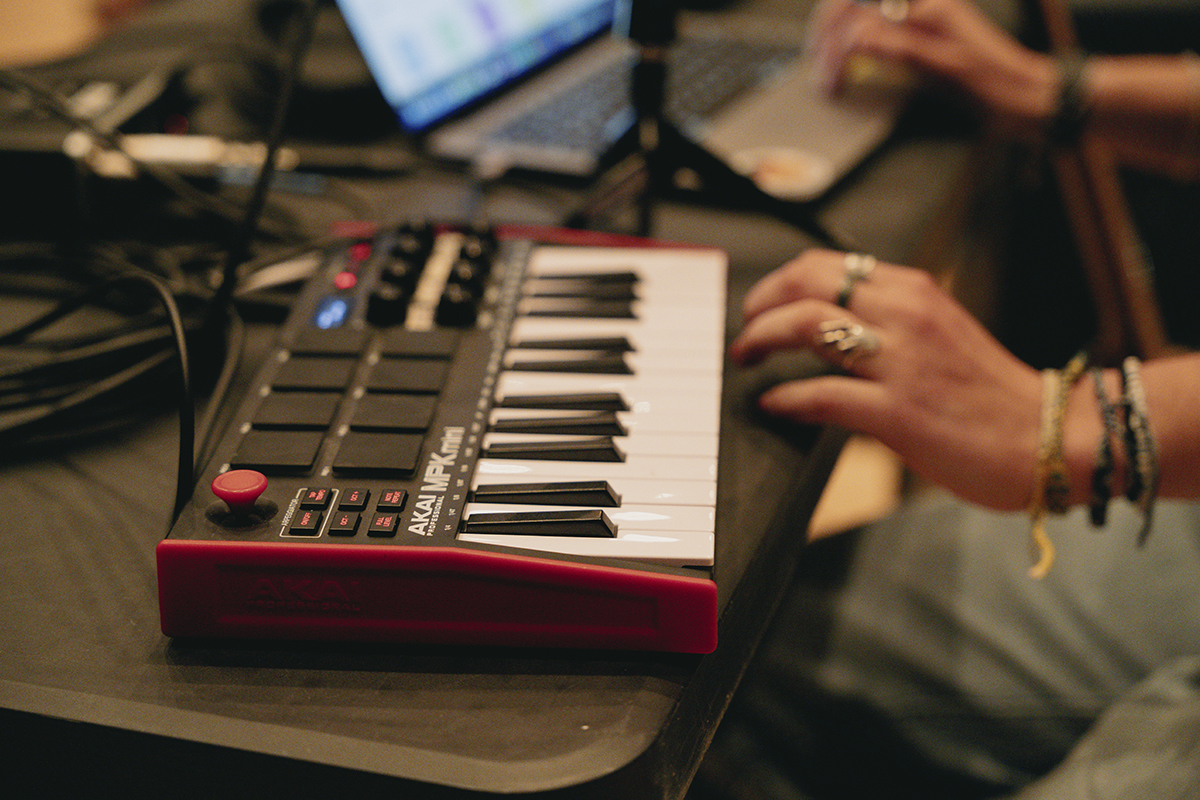It begins with a voice calling out, “Follow a new norm.”
Four dancers dressed in black move to the center of the dimmed Emory Performing Arts Studio, where they fall, gracefully, to the floor and begin twisting and untwisting their limbs like the wings of butterflies freshly slipped from their cocoons. Musicians sit at a table in each corner of the room behind laptops, touchpads and keyboards.
A moment later, sound floods the room.
The Friday night jam session took place as part of a semester-long collaboration between an Emory live electronic music composition class and an improvisatory dance class at Spelman College.
The joint class is one of three this semester in Emory’s Arts and Social Justice Fellows (ASJ) program, which is celebrating its fifth year. The program is a partnership of Emory College of Arts and Sciences, Emory Arts and the Emory Center for Ethics that brings artists into classrooms to reimagine an existing course, exploring creative approaches to address the issues that surface within class conversations.
This fall’s courses culminated in a live student showcase featuring all three classes at The Supermarket, an event space in Poncey-Highland.

Senior Peiming Yang (left) and first year student Marvin Xu at the class’s November jam session
“Usually, it’s a small group of undergraduate students learning to compose experimental electronic music that they can play live, with laptops and maybe a few synthesizers,” he says.
But in addition to recording and editing samples and programming their own musical instruments, students in this semester’s ASJ version of the class are also working with the dance class at Spelman and experimenting with AI, the social justice topic theme that both classes are taking on.
“We’ve been throwing stuff at them and they’re just going with it,” Mirza says.
The “we” includes ASJ Fellow Kacie Luaders, an Atlanta podcast and sound artist, who is co-teaching with Mirza and T. Lang, an associate dancer professor at Spelman.
The music starts with sounds of police sirens fading in from one corner, which is soon eclipsed by a bass rhythm. Another musician complements this beat with a rhythmic tapping and together, the beats crescendo. The dancers’ syncopated movements intensify, too, before the music shifts and bridges into something atmospheric and dreamy.
All the while, Mirza prompts the musicians, encouraging more from one while fading down another with a gesture. At one point, he motions to students in opposite corners, shouting for one to “pass the energy!” to the other.
The music settles into a profound calm. Resolution.
AI as creative opportunity

“I feel like I am a reflection of [the dancer’s] movements,” says Ella Ferguson, a sophomore who enjoys deejaying in her spare time.
“When GPTs and generative AI first came out, my first thought wasn’t, ‘Oh, no; they’re going to steal our jobs! They’re going to steal humanity!’” she says. “My first thought was, ‘How can I use this to make cool stuff?’”
Luaders says she hopes that the Emory and Spelman students she’s working with come away with a similar glass-half-full approach to AI, which they’ve threaded into many aspects of this semester’s work.
The prompts that begin each musical jam, (like “Follow a new norm,”) come from a chatbot that Luaders designed. It dispenses excerpts from poems written by the Spelman dance students.
In composing the five-minute pieces they performed in duets with the dance students at the showcase, the Emory students have also experimented with a variety of AI tools.
These have included employing so-called “mapping” software that allows AI to generate novel combinations of the sounds and effects the students have created. One student has generated an AI song that she plans to distort and remix when she performs it live. Luaders is also creating a voiceover consisting of an interview she conducted with an AI chatbot.
Meanwhile, class discussions wrestle with large questions, says Mirza. “Things like: What implications does AI actually have for social justice? Is it going to take datasets not representative of the people, and what implications does that have?”
The students bring these ideas to bear in the emotional landscape of their musical compositions, even as they use the technology to create new sounds.
Kevin Karnes, senior associate dean of faculty and divisional dean of arts, says that this semester’s class exemplifies the goals of the ASJ program. “Working with T. Lang’s students at Spelman, our undergraduate composers become part of a community of young artists,” he says. “And they’re really coming together to imagine how their artistic work can positively impact the world in which we all live.”
Highlighting the human
Few of the Emory students in Mirza’s class are music majors.
“And that’s been the cool part,” he says. “Seeing the students realize that they have the capability to make powerful music events happen and that they can engage with a certain confidence.”
There’s also something to be said for having fun, Luaders says. “Because being an artist or a creator doesn’t have to mean ‘I want to do this full time,” or ‘I want to make this my job.’ It can also just be, ‘I enjoy this.’ They’re expanding their own possibilities.”

Sophomore Vi Eicher plays during November’s jam session.
Even with a focus on AI, the class’s most compelling connections may be thoroughly human.
Late in a jam session, one inspired musician — sophomore Ella Ferguson, a business major — begins tapping a set of car keys on a metal contact microphone, moving her own body to the resulting booming beat as the dancer she’s paired with rotates and pivots a few feet away.
In such moments, “I feel like I am a reflection of her movements,” says Ferguson, who enjoys deejaying in her spare time. When everything clicks into place, she says, “It’s just a feeling. When you feel that connection, you know.”
AI enthusiast that she is, Luaders says this kind of connection may be what matters most.
“This tech is cool!” she says. “It can help to potentially do useful things for creativity. But the heart of what we’re doing is people coming together, collaborating. In the grand scheme of things, tech and AI will always come second to that.”
Emory Arts and Social Justice Project Showcase
The showcase, highlighting the work of the Emory Arts and Social Justice program, featured performances, interactive exhibits and community conversations.
Courses taking part in this year’s showcase
Culture, Arts and Social Movements
Lydia Fort, assistant professor in theater studies partners with Jasmine Nicole Williams, a printmaker and muralist.
Global Health Overview by Education and Engagement (GLOBE) Track (Emory School of Medicine)
Anna Yaffee, associate professor of emergency medicine, and Jay Shah, pediatric and interventional radiologist at Children’s Healthcare of Atlanta, partner with Umi IMAN, indigenous arts curator and dancer.
Live Electronic Music (Emory College) and Improvisation II: Movement Invention (Spelman College)
Adam Mirza, assistant professor in composition at Emory University, and T. Lang, associate professor and inaugural department chair of dance performance and choreography at Spelman College, partner with with Kacie Luaders, a sound designer and podcaster.

